OS X Yosemite release date confirmed as 16 October
OS X Yosemite available to download today

The OS X Yosemite release date has been confirmed as Thursday 16 October at Apple's launch event in Cupertino, where the consumer electronics giant is later expected to debut new iPads and Macs.
Like previous OS X releases, the software is being made as a free upgrade to Mac users.
The latest version of Apple's OS X software made its debut in June at the firm's WWDC event, and since then numerous public and private beta versions of the software have been released for developers and Apple users to try out.
These have resulted in a number of new features, as well as performance tweaks and improvements, being made to the OS. For example, one of the most recent beta releases resulted in slight alterations to the System Preferences screen and taskbar battery icon. There was also a Do Not Disturb option added to the software's Notification centre.
Another release, OS X Yosemite beta 5, also sported updates to fix various bugs, and introduced a number of redesigned features and other improvements.
Included in the beta was an easier-to-use Swift, altered design for the Calculator app, system preferences bar and volume and brightness controls, and a new option to view full URLs in Safari or consensed versions.
The first OS X Yosemite public Beta was previously made available to the public in late July, and limited to the first one million sign-ups. At the time of writing, the registration page was still live, suggesting Apple may not have signed up as many potential testers as anticipated. Earlier this week, Apple pushed out another public beta update to its troop of registered testers.
Get the ITPro. daily newsletter
Receive our latest news, industry updates, featured resources and more. Sign up today to receive our FREE report on AI cyber crime & security - newly updated for 2024.
The public beta programme is a first for Apple, as it tends to limit testing of its new software offerings to developers and its in-house staff, and could pave the way for similar schemes being introduced in future for its iOS mobile operating system.
Meet Yosemite
Yosemite features a revamped design, improvements to core apps along with a "Continuity" feature, which deeply integrates iOS and Mac devices.
Craig Federighi, SVP of software engineering at Apple, walked attendees through a bucket-load of Yosemite's new features on stage at WWDC in June 2014.
He kicked off by introducing the refreshed design. OS X Yosemite uses simplified icons for the dock and a translucent display. This means windows will adapt to the shade of the background wallpaper.
Below, we run through Yosemite's key new features.
Continuity
This is the amalgamation of numerous features, beginning with the ability to use Airdrop across Mac and iOS devices.
A feature called "Hand-off" allows users to switch devices when working on a document or email and pick up where you left off.
Federighi demoed this on-stage by beginning to compose an email on his iPhone. Using "proximity awareness" his Mac realised he was close by and a prompt appeared in the dock asking him if he wanted to finish writing the message on the Mac. This also works visa-versa, so you can finish off a task you started on your iOS device.
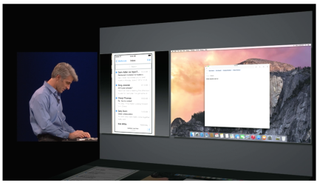
It's now possible to create a Wi-Fi hotpot directly from you Mac without having to touch your iPhone, too. Everything is synced automatically through your account.
OS X 10.10 Yosemite release dateYosemite is available now for Apple developers.For the first time Apple is also launching an OS X beta programme - allowing members of the public to access the software in the summer.
General availability will begin "in the fall". The software update will be available free.
Finally, iPhones are now able to display all text messages on Mac and the desktop can even be used to accept an incoming call or make an outgoing call. Federighi demoed this by making a phone call to Dr. Dre on-stage using his Mac, and telling the rapper that new employees should report for orientation at 9am.
Notifications Center
Apple introduced a "Today view" showing all your calendar appointments, reminders, and weather updates. Third party apps can be integrated into the sidebar to increase usefulness and increase customisation.
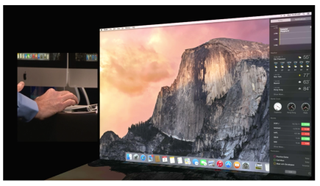
Spotlight
The search functionality has been completely revamped. A big search bar appears in the middle of the screen. Not only can you search for documents and contacts locally, Spotlight is able to pull down content from the the web and bring up results from Wikipedia or Maps. Best of all when you search for something you get an in-line preview.
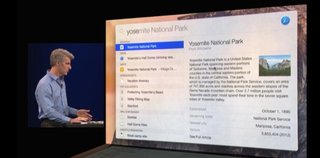
iCloud drive
This allows you to store files and folders in the iCloud, sync them across all Macs devices and access them from the Finder. This will be compatible with Windows too.
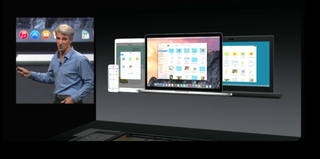
Meanwhile, "Mark up" allows you to sign a PDF using either a signature captured by your iSight camera or by drawing on your trackpad.
MailDrop
Apple has revamped the Mail app, but the most interesting feature is now the ability to sent 5GB attachments using the cloud.
"We wanted to address a fundamental problem with email - we often want to send large attachments, but we can't because the recipient can't handle the file," Federighi said.
MailDrop allows users to upload a file of up to 5GB and creates a secure link, which can be sent to users.
Safari
Apple has stripped down the interface for its default Safari web browser to the bare bones. When you click on the search bar it shows you favorites and you get spotlight suggestions.
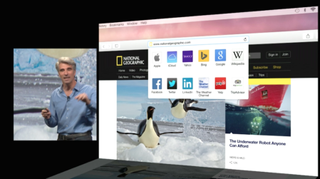
Private browsing tabs can be created without affecting other tabs. And it's possible to scroll through multiple tabs. The new tab view also gives a graphical overview of everything which is open.
Perhaps the best feature is reserved for multimedia fans. Safari has built-in support for HTML5 Premium video. Apple claims users can stream video from Netflix without the need for a plug-in and this will add up to two hours of extra battery life on devices such as the MacBook Air.
This article was first pubilshed on 02/06/14 and has been updated multiple times (most recently on 14/10/14) to reflect new information that has become available since its original publication.
Caroline has been writing about technology for more than a decade, switching between consumer smart home news and reviews and in-depth B2B industry coverage. In addition to her work for IT Pro and Cloud Pro, she has contributed to a number of titles including Expert Reviews, TechRadar, The Week and many more. She is currently the smart home editor across Future Publishing's homes titles.
You can get in touch with Caroline via email at caroline.preece@futurenet.com.





